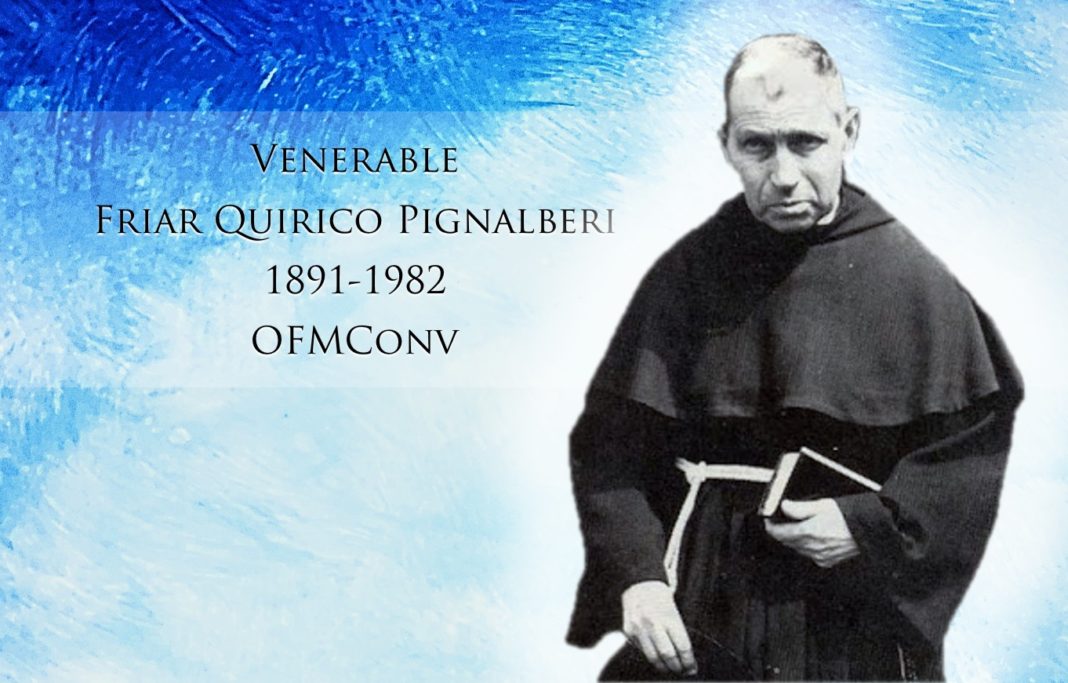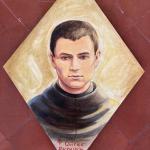Quirico PIGNALBERI was born in Serrone, Italy, on July 11, 1891. He was the last of five children of Egidio and Caterina PROIETTI. One day after his birth, Quirico was baptized in the Sacro Cuore di Gesù Church in La Forma, a hamlet of Serrone. At just two years of age, following the custom of the time, he received the Sacrament of Confirmation on September 29, 1893, from His Eminence, Angelo Cardinal BIANCHI, Cardinal-Bishop of Palestrina (Rome).
Quirico attended elementary and high school in Italy. During elementary school, an incident took place which ruined the carefree nature of his childhood. His teacher instructed him to keep order among the students and then left the classroom. A few moments later, a gunshot was heard; the teacher had committed suicide rather than obey the Freemasons who had ordered him to assassinate King Umberto I. Nevertheless, that assignment would be carried out, as is known, by the anarchist Gaetano BRESCI on July 29, 1900. This had a profound effect on Quirico and throughout his life he always chose to fight against the enemies of God and the Fatherland.
A much happier event occurred when Quirico was about to receive First Communion. The nun who had been preparing him spoke so passionately about the dignity of the priesthood that it made a lasting impression on Quirico.
On October 30, 1908, at seventeen years of age, he entered the Order of Friars Minor Conventual. He began his novitiate year in Zagarolo (Rome) and made his simple profession on November 14, 1909. After completing high school, he was sent to Rome to study philosophy (1911-1913) at the Pontifical Gregorian University and later studied theology (1914-1917) at the Pontifical Faculty of St. Bonaventure, also known as the “Seraphicum”, the international college of the Order of the Friars Minor Conventual.
It was during his studies at the Seraphicum that he met and befriended a clerical student from Poland, Friar Maximilian M. KOLBE. The future St. Maximilian regarded Friar Quirico so highly that on October 16, 1917, he persuaded him to become a co-founder, along with six other friars, of the Militia of the Immaculata (M.I.).
On August 10, 1917, Friar Quirico was ordained to the priesthood. The First World War was then underway and like other religious and diocesan priests of the period, he was enlisted in the Italian Sanitary Corps and was sent to the second line of the war front, at Arcade in the Italian Province of Treviso.
In 1918, with the war ended, Friar Quirico was sent to Rome to serve in various communities of the Order. In 1919, he first served in Capranica; then in 1920, he was transferred to Cave where he served as the Rector of seminarians.
In 1925 he was appointed Novice Master in Bagnoregio, Italy. After that, he served as the Guardian at the San Lorenzo Friary in Piglio, Italy. While performing these delicate tasks, he formed generations of young men in the Franciscan life, giving witness above all with his own holiness of life. Because of his willingness to serve in the apostolates of preaching and reconciliation, he was continually requested by bishops and pastors in neighboring countries.
Emulating the Holy Founder Francis, Friar Quirico lived an austere, simple and poor life, devoted to prayer and steeped in contemplation. He practiced a harsh penitential regimen comprised of fasting, mortification, bodily discipline and prolonged night vigils. He ate only what was necessary and quenched his thirst with hot water.
He would always stand in a corner so as not to be noticed or disturb others. He preferred not to insert himself into a conversation, but, if necessary, he did so with gentleness and moderation, except when it was necessary to defend the truth: then he became energetic, insisting to the point of stubbornness and monotony. He never wanted to be photographed. He often devoted himself to agricultural work and gardening, yet he always dressed cleanly and modestly and was never slovenly.
In 1937, while Friar Maximilian KOLBE was traveling through Italy to better organize the M.I., he stopped by Piglio to see his old fellow student again; it was the last time they would ever meet.
On September 8, 1943, the Second World War concluded in Italy. In the aftermath, the Italian army was in disarray. Many of its commissioned and non-commissioned officers were temporarily housed in the friary where they would be passed off as traveling religious or displaced persons. On April 3, 1944, the Germans took over part of the friary, as they had done with various other communities in the area. Not least of these was the Benedictine Monastery of Montecassino), which the Allies bombed on May 12, 1944. Friar Quirico was at the forefront of a long and hard effort to rebuild the structure and resume its activities.
Curiously, Friar Quirico had a hobby of repairing clocks, but he transformed it into an apostolic work, doing free repair work for anyone who asked him. His passion for precision technology led him to enter an artistic nativity scene in the European Nativity Scene Exhibition in Milan, where he received an award for his ingenious and intricate arrangement.
He left Piglio only twice: once in 1958, when he made a pilgrimage to Lourdes on the 100th anniversary of the apparitions, and once in 1971, when he traveled to Poland to take part in the celebrations for the beatification of Friar Maximilian M. KOLBE, held in Cracow, Niepokalanów and the Auschwitz concentration camp.
Friar Quirico had always been frail, but as he aged, his health was further undermined by illness. He was first admitted to the Santo Spirito Hospital in Rome with a serious case of pleurisy, then, following a fall, he was treated at Anagni Hospital in the Italian Province of Frosinone. Finally he was placed in the “La Francescana” nursing home in Anzio Colonia (Rome), and was confined to a wheelchair.
In 1967, although infirm, he celebrated his 50th anniversary of priesthood. On April 1, 1979, he had the consolation of a meeting with Pope St. John Paul II who embraced him and recognized him as the last living member of the founders of the M.I.
After fifteen years in a nursing home, offering his sufferings to the Lord, Friar Quirico died in Anzio on July 18, 1982, at the age of 91. He was initially buried in his family’s tomb in Serrone. However, on March 30, 1985, his remains were transferred to the Friary of San Lorenzo in Piglio, and enshrined in the friary’s Sacro Cuore Chapel.
As the faithful’s devotion to Friar Quirico spread, the Postulator General of the Conventual Franciscan Order, Friar Ambrogio SANNA, made a request dated February 11 1992, to the Most Reverend Dante BERNINI, Bishop of Albano (Rome) to begin the cause of canonization for Friar Quirico, who had, in fact, died in the territory of that Diocese. It was also where the religious had worked for about fifty years.
On June 20, 1992, the Bishop of Anagni inaugurated the diocesan investigation for the cause of beatification. On July 9, 1992, the Holy See granted the nulla osta. On July 1, 2005 the investigation concluded and was validated on February 9, 2007. The “Positio super virtutibus” was then taken to Rome inServ 2011.
On February 3, 2015, it passed to the Theological Consultors, who gave their approval. On February 9, 2016, the Cardinals and Bishops of the Congregation for the Causes of Saints also gave a favorable opinion. Finally, on March 3, 2016, Pope Francis authorized the promulgation of the decree proclaiming him to be Venerable, confirming that Friar Quirico had exercised Christian virtue to a heroic degree.
Antonio BORRELLI
www.santiebeati.it


















